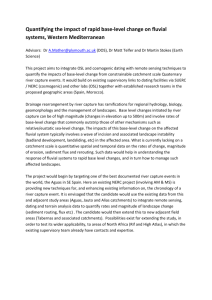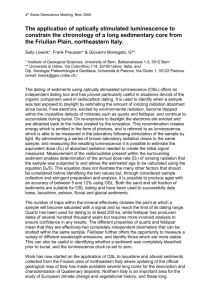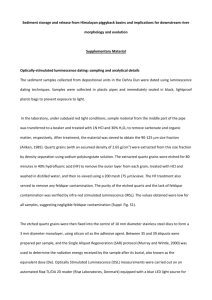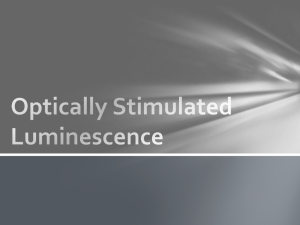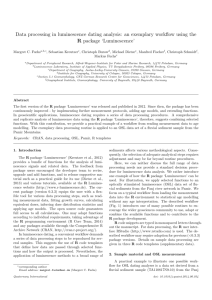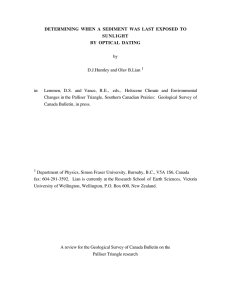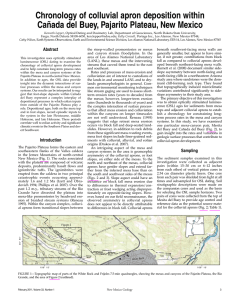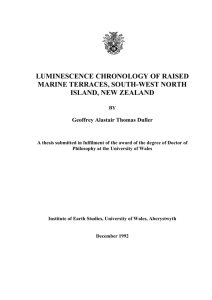jgrb51288-sup-0001-2102SI
advertisement
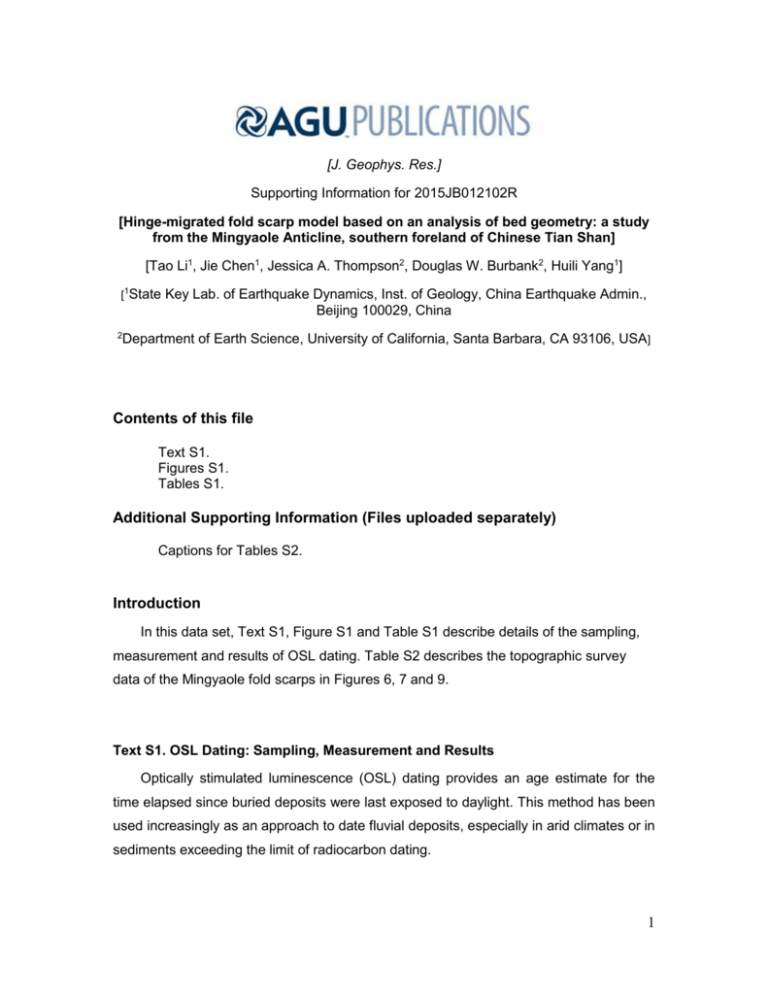
[J. Geophys. Res.] Supporting Information for 2015JB012102R [Hinge-migrated fold scarp model based on an analysis of bed geometry: a study from the Mingyaole Anticline, southern foreland of Chinese Tian Shan] [Tao Li1, Jie Chen1, Jessica A. Thompson2, Douglas W. Burbank2, Huili Yang1] [1State Key Lab. of Earthquake Dynamics, Inst. of Geology, China Earthquake Admin., Beijing 100029, China 2 Department of Earth Science, University of California, Santa Barbara, CA 93106, USA] Contents of this file Text S1. Figures S1. Tables S1. Additional Supporting Information (Files uploaded separately) Captions for Tables S2. Introduction In this data set, Text S1, Figure S1 and Table S1 describe details of the sampling, measurement and results of OSL dating. Table S2 describes the topographic survey data of the Mingyaole fold scarps in Figures 6, 7 and 9. Text S1. OSL Dating: Sampling, Measurement and Results Optically stimulated luminescence (OSL) dating provides an age estimate for the time elapsed since buried deposits were last exposed to daylight. This method has been used increasingly as an approach to date fluvial deposits, especially in arid climates or in sediments exceeding the limit of radiocarbon dating. 1 We collected samples from silt-fine sand lenses within gravel fluvial terraces. Under subdued red light, the sample were pretreated with 30% HCl and 30% H2O2 to remove carbonates and organics and then sieved to isolate the 180-250 or 125-180 μm fraction. Quartz and feldspars were separated using heavy liquid (Li-Polytungstate, ρ=2.62g/cm3). The quartz grains were etched with 40% HF for 40 min, followed by 10% HCl treatment for 180 min, to remove the α-affected external coating of the grains and residual feldspars, if any. The grains were mounted on 9.7-mm steel disks using silicone gel to create small aliquots (~2-mm mask diameter samples). Potential feldspar contamination was tested using infrared stimulated luminescence. The equivalent dose (De) (Figure S1; Table S1) was measured on a Riso TL/OSLDA-20 system equipped with a calibrated 90 Sr/90Y source (0.0848 Gy/s), blue (470±30 nm; ~50 mW/cm2) and infrared (IR: 880nm, ~145 mW/cm2) light sources, and detection through a 7-mm thick U-340 glass filter. Luminescence measurements were made at 125°C to prevent re-trapping in the 110°C TL trap with both IR and blue light stimulation power at 90%. Luminescence emissions were detected by an EMI9235QA photomultiplier tube with a 7-mm U-340 glass filter. Measurements were made following a SAR protocol [Murray and Wintle, 2003], with an optical thermal wash at the end of each cycle. We used a preheat of 260°C and a cutheat of 220°C based on a preheat plateau and dose-recovery test of sample LED11-61 and LED11-64. Additional tests for the reliability of the SAR protocol on our samples included sensitivity change and dose recovery. The De of all samples was calculated using the minimum age model (MAM) (Figure S1; Table S1; Galbraith and Laslett, 1993). The annual dose rate (Table S1) was determined from the concentrations of radioactive elements and the water content of sediment, converted using standard factors from Aitken [1998]. For sample LED12-303, concentrations of U, Th, K, and Ra were measured using Ge γ-ray spectrometer. For other samples, contents of U, Th and K were quantified using other methods. The contents of U and Th were measured using the thick-source alpha counting technique, and the content of K was evaluated using Xray fluorescence. For all samples, the contribution of cosmic ray was also included. The water content can significantly influence the dose rate: ~1% increasing can decease the dose rate by about the same amount. These samples had dried out before sampling, but were saturated by water when deposited. However, we don’t known when they were raised above the water table and became dry. In order to cover all likely values, we 2 apply an uncertainty equivalent to the average between the dry (0% water content) and saturated values to represent its water content. References Aitken, M. J., (1998), An Introduction to Optical Dating: The Dating of Quaternary Sediments by the Use of Photon-stimulated Luminescence, Oxford University Press, Oxford. Galbraith, R. F., and G. M. Laslett, (1993), Statistical models for mixed fission track ages, Nuclear Tracks and Radiation Measurements, 21, 459-470. Murray, A.S., Wintle, A.G., (2003), The single aliquot regenerative dose protocol: potential for improvements in reliability. Radiat. Meas., 37, 377-381. 3 Figure S1. OSL dating results of samples collected from fluvial terraces at Kalangoulvke South. Left panels are the MAM (minimum age model) fit (pink zone with black solid outer line) and cumulative frequency (red circle, with 1σ standard error). N is the number 4 of accepted aliquots (out of total aliquots measured). Right panels are radial plots of the same data. Red circles and yellow bar represents aliquots and component used in the MAM. 5 Sample No. Depth (m) Grain Size (μm) Aliquotsb Bulk Alpha (ks-1.cm-2) K (%) SWCc (%) WCc (%) Dose Rate (Gy/ka) MAMd De (Gy) Terrace LED11-60 2.6 180-250 52(92) 5.5±0.1 1.45 24 12±12 2.0±0.1 9.7±1.3 T1 LED11-61 1.0 180-250 48(67) 5.4±0.1 1.35 26 13±13 2.0±0.1 8.3±1.1 T1 LED11-63 1.0 125-180 55(77) 4.4±0.1 0.98 22 11±11 1.6±0.1 24.7±3.1 T3 LED11-64 1.2 180-250 64(125) 4.2±0.1 0.66 23 12±12 1.3±0.1 20.6±2.3 T3 LED12-304 1.3 180-250 58(102) 5.9±0.1 1.66 36 18±18 2.2±0.1 26.2±2.8 T3 aAll samples were analyzed using a single aliquot regeneration (SAR) protocol [Murray and Wintle, 2003] on small aliquots of quartz grains. Measurements were made in the State Key Laboratory of Earthquake Dynamics, Institute of Geology, China Earthquake Administration. bNumber of accepted aliquots used in De (equivalent dose) calculation, out of total aliquots measured. cSWC stand for lab measured saturated water content of the sample. WC stands for water content assumes an average of 0% (dry sample) and measured saturated water content. dMAM-minimum age model [Galbraith and Laslett, 1993]. Sample No. Depth (m) Grain Size (μm) Aliquots U (ppm) Th (ppm) K (%) Ra (ppm) SWC (%) WC (%) Dose Rate (Gy/ka) MAM De (Gy) Terrace LED12-303 2.3 125-180 49(81) 1.27±0.28 1.62±0.02 3.1±0.06 1.31±0.02 38 19±19 1.5±0.2 21.4±3.0 T3 Table S1. OSL Dating Results for Samples Collected from Fluvial Terraces at Kalangoulvke Southa Table S2. Topographic Survey Data of the Mingyaole Fold Scarps in Figures 6, 7 and 9. 1
